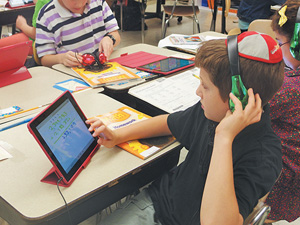

Has a student’s day really been turned upside down? Is it true that some teachers are teaching their students at home, after the end of the school day, and their students are completing their homework in class? It’s not Purim. It’s not backwards day. It’s the flipped classroom.
October 1st was Flipped Day, a day when educators across the globe flipped a lesson. Instead of delivering content for a particular lesson from the front of the classroom, teachers all across the world created their own recording of that content ahead of time or curated a recording someone else had created. While this year marked the second annual Flipped Day, Mrs. Sharon Sherman at Yavneh Academy, makes almost every day Flipped Day in her 5th grade math class.
Instead of pure frontal teaching, Mrs. Sherman records almost every new math lesson on an app called “Explain Everything” that operates like an electronic blackboard. Each recorded lesson varies in time but on average runs about six or seven minutes. When her students get home from school, they watch the video (on occasion the students watch the video with their own headphones and device in class), take notes, and answer two or three questions (prepared by Mrs. Sherman to check their understanding of the material) on-line. In class the next day, Mrs. Sherman does a quick five-minute review. Students can ask questions about the video, and they take out their “homework” books and apply the knowledge learned through the videos to the work they do in the classroom.
Recently, Mrs. Chani Lichtiger, Director of Technology, sat in on one of the flipped lessons and asked students what their thoughts were on the new way they were learning math. One student thought it was fantastic. The student explained that in the past if she understood a concept but another student needed the concept taught again, she would sit in class bored. Now she sits at home and watches the lesson. If she understands everything on the video, she doesn’t have to wait for anything to be explained again.
Another student also thought this new method of teaching was great because if he didn’t understand something on the video, he could rewind the video and play it again. Still another student praised the flipped lesson by saying how she used to go home and spend a lot of time trying to remember how to do a calculation taught in class earlier that day. Now she says “homework” doesn’t take so long since the teacher, or her classmates, are able to answer her questions quickly. Another student spoke about her parent watching the video with her and how her parent now understands “how Mrs. Sherman teaches math concepts.”
There are a number of benefits to the flipped lesson. First, students can review and replay an instructional segment as many times as necessary. In addition, students have greater control over their learning. They can move quickly or take time to process material. Students take responsibility for their own learning. Also, in the flipped classroom, the teacher is able to provide greater support and help to students who struggle with the application of the content, and provide enrichment to those students who understand the content with ease. Increased interaction and personalized contact time between the teacher and the student is possible.
Another benefit of this new innovative teaching method is that more class time is available for additional learning, whether it is class-wide enrichment or additional review of material.
Finally, students can review and study as often as they want because the videos are always available. Even students who are absent don’t miss out because the content is available on-line. With flipped learning, the teacher is no longer the “sage on the stage,” but the “guide on the side.”
While preparing daily math videos is very time consuming, the successes Mrs. Sherman has seen so far with her students’ understanding the material makes it worth her effort and hard work. Mrs. Sherman’s goal is to continue preparing math lessons using the flipped innovation method.









